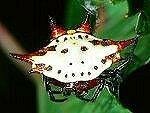Home > Don't just hike > Three SSS > Spiders
Creepy crawlies ...
Spiders
Chiracanthium – a sac spider
This little beast is one of the many thousands of spider species found in Africa. It is one which has taken to urban and domestic living.
Outside they spin a few silk threads in the hollows of leaves to make a sac. Indoors they make a small hammock in a corner to rest in. They are easily distinguished by their huge shiny back chelicerae (mouth parts) which are as if carved out of jet.
They are small, and looked at through a magnifying glass, it can be seen that they are covered with delicate flat hairs of a soft yellow, flushed towards the front with salmon pink. These hairs lie in a twill pattern; their only unaesthetic feature is a number of short, sparse black bristles randomly scattered on their legs, as well as the usual soft tufts of hairs. Apart from the eyes, in this case arrange in two rows of four, spiders sense with their legs. They may be chemoreceptors or mysterious pheromones, or tiny meteorological stations to detect tiny variations in temperature, pressure and humidity. These animals are very fast. At night they roam around preying on soft bodied creatures such as fishmoths.
The Chiracanthium has a nasty nature and often bites sleeping humans, not because they are being disturbed by them and it is unlikely that they recognize them as food. The venom is cytotoxic. A bite typically shows two bite marks from 4 to 8mm apart. Local inflammation follows, then, after a few days, ulceration. These lesions are usually small, but may take weeks or months to heal.
The kite spider, Gasteracanthus sanguinofenta, is a diurnal species that occupies the higher zones amongst trees, a metre and higher above the ground.
The abdomen is wider than long, coloured red, yellow and black and porcelain-like with six projections on the abdomen – two laterally and two posteriorly. The legs are short and black. This is typically a tropical and sub-tropical species but its range extends as far as Cape Town.
The Araneidae (with another orb-web family, Tetragnathidae) occupy a niche not utilized by other spiders. They occupy the aerial passage amongst vegetation in the path of flying insects. The spider sits on the web waiting for prey to get trapped on the web. Once prey is caught, the spider then cautiously approaches the prey, wraps it in silk to immobilize it and kills it with a bite. The prey is then moved to the centre of the web and consumed.
Links: Kite spider



